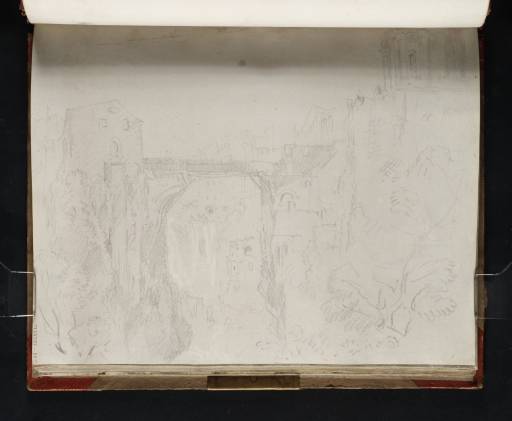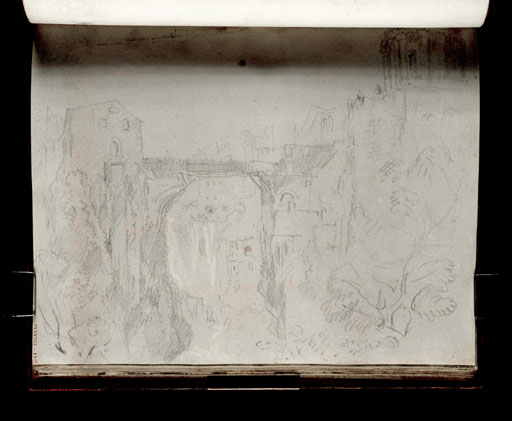Joseph Mallord William Turner Ponte San Rocco and the So-Called Temple of Vesta, Tivoli 1819
Image 1 of 2
Joseph Mallord William Turner,
Ponte San Rocco and the So-Called Temple of Vesta, Tivoli
1819
Joseph Mallord William Turner 1775–1851
Folio 27 Recto:
Ponte San Rocco and the So-Called Temple of Vesta, Tivoli 1819
D15494
Turner Bequest CLXXXIII 27
Turner Bequest CLXXXIII 27
Pencil and grey watercolour wash on white wove paper, 200 x 253 mm
Inscribed by ?John Ruskin in red ink ‘27’ bottom left, descending left-hand edge
Stamped in black ‘CLXXXIII 27’ bottom left, descending left-hand edge
Inscribed by ?John Ruskin in red ink ‘27’ bottom left, descending left-hand edge
Stamped in black ‘CLXXXIII 27’ bottom left, descending left-hand edge
Accepted by the nation as part of the Turner Bequest 1856
References
1909
A.J. Finberg, A Complete Inventory of the Drawings of the Turner Bequest, London 1909, vol.I, p.541, as ‘Wooden bridge over a broken stone arch, near the Temple of the Sibyl’.
The subject of this study is the Ponte San Rocco, Tivoli, a wooden bridge which had been erected on the broken arch foundations of a stone bridge, previously swept away in a flood in 1808. The crossing spanned the gully between the so-called Temple of Vesta, visible in the top right-hand corner, and the Church of Santa Maria del Ponte, on the opposite side. Turner’s view looks south from a point beneath the ancient temple towards the ‘Grand Cascade’, the former falling point of the River Aniene where it plunged into the Valle d’Inferno (Valley of Hell) to the north-east of the town. Related sketches can be seen in the Tivoli and Rome sketchbook (Tate D14936–D14937 and D15096; Turner Bequest CLXXIX 2a–3 and 88a). Like many drawings within this sketchbook, the composition has been executed over a washed grey background. Turner has created highlights within the work by rubbing or lifting out the wash to reveal the white paper beneath, principally to describe the waterfall visible beyond the bridge.
The picturesque properties of this prospect had made it a popular subject for artists, and by the early nineteenth century it was a well-established topographical motif. An early example is Gaspar van Wittel’s (1652/3–1736), View of Tivoli circa 1700 (Walters Art Gallery, Baltimore), which pictures an artist sketching the view from a point below the Temple of Vesta.1 Similar vistas incorporating the original stone Ponte San Rocco include a drawing and related print by Albert Christophe Dies (1755–1822) published in Vues Pittoresques de l’Italie (circa 1795),2 François-Marius Granet (1775–1849), Ponte San Rocco and Falls, Tivoli circa 1810–20 (Metropolitan Museum of Art, New York) and Revd William Henry Barnard (1767/9–1818), Tivoli (Tate, T09427). Contemporaneous views, meanwhile, depicting the temporary wooden bridge, include an illustrations in Italian Scenery from drawings made in 1817 by Miss Batty (published 1820),3 and in a drawing by James Hakewill (1778–1843), Tivoli 1817 (British School at Rome Library).4
It is no longer possible to find the same vantage point in present-day Tivoli. A devastating flood in 1826 persuaded Pope Gregory XVI to divert the course of the river away from the residential district. Consequently, the town’s many waterfalls, including the Grand Cascade near to the temples of the Acropolis, were replaced instead by the great waterfall in the Villa Gregoriana to the north-east of the town. Furthermore, the topography of the town was vastly altered, and the wooden Ponte San Rocco was succeeded by the newly-built Ponte Gregoriano.
The drawing is reproduced in colour in Raymond Keaveney, Views of Rome from the Thomas Ashby Collection in the Vatican Library, exhibition catalogue, Smithsonian Institution, Washington 1988, no.71, p.[257].
[Elizabeth Frances] Batty, Italian Scenery from Drawings Made in 1817 by Miss Batty, London 1820, opposite p.115.
Verso:
Blank, except for traces of grey watercolour wash
Inscribed by ?John Ruskin in red ink ‘347’ bottom left
Blank, except for traces of grey watercolour wash
Inscribed by ?John Ruskin in red ink ‘347’ bottom left
Nicola Moorby
February 2010
How to cite
Nicola Moorby, ‘Ponte San Rocco and the So-Called Temple of Vesta, Tivoli 1819 by Joseph Mallord William Turner’, catalogue entry, February 2010, in David Blayney Brown (ed.), J.M.W. Turner: Sketchbooks, Drawings and Watercolours, Tate Research Publication, December 2012, https://www


